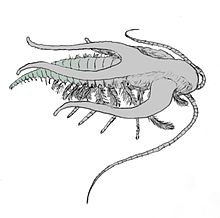Marrella
|
Marrella splendens Temporal range: Mid Cambrian |
|
|---|---|
 |
|
| Fossil Marrella | |
 |
|
| Reconstruction of Marrella | |
| Scientific classification | |
| Kingdom: | Animalia |
| Phylum: | Arthropoda |
| Class: | Marrellomorpha |
| Order: | Marrellida |
| Family: |
Marrellidae Walcott, 1912 |
| Genus: |
Marrella Walcott, 1912 |
| Species: | M. splendens |
| Binomial name | |
|
Marrella splendens Walcott, 1912 |
|
Marrella splendens is an arthropod known from the middle Cambrian Burgess Shale of British Columbia. It is the most common animal represented in the Burgess Shale.
Marrella was the first fossil collected by Charles Doolittle Walcott from the Burgess Shale, in 1909. Walcott described Marrella informally as a "lace crab" and described it more formally as an odd trilobite. It was later reassigned to the now defunct class Trilobitoidea in the Treatise on Invertebrate Paleontology. In 1971, Whittington undertook a thorough redescription of the animal and, on the basis of its legs, gills and head appendages, concluded that it was neither a trilobite, nor a chelicerate, nor a crustacean.
Marrella is one of several, unique, arthropod-like organisms that have been identified in this notable geological formation. Other examples are Opabinia and Yohoia. The unusual and varied characteristics of these creatures were startling at the time of discovery. The fossils, when described, helped to demonstrate that the soft-bodied Burgess fauna was more complex and diverse than had previously been anticipated.
Marrella itself is a small animal, 2 cm or less in length. The head shield has two pairs of long rearward spikes. On the underside of the head are two pairs of antennae, one long and sweeping, the second shorter and stouter. Marrella has a body composed of 24–26 body segments, each with a pair of branched appendages. The lower branch of each appendage is a leg for walking, while the upper branch is a long, feathery gill. There is a tiny, button-like telson at the end of the thorax. It is unclear how the unmineralized head and spines were stiffened. Marrella has too many antennae, too few cephalic legs, and too few segments per leg to be a trilobite. It lacks the three pairs of legs behind the mouth that are characteristic of crustacea. The legs are also quite different from those of crustaceans. The identification of a diffraction grating pattern on well-preserved Marrella specimens proves that it would have harboured an iridescent sheen—and thus would have appeared colourful.Dark stains are often present at the posterior regions of specimens, probably representing extruded waste matter.
...
Wikipedia
